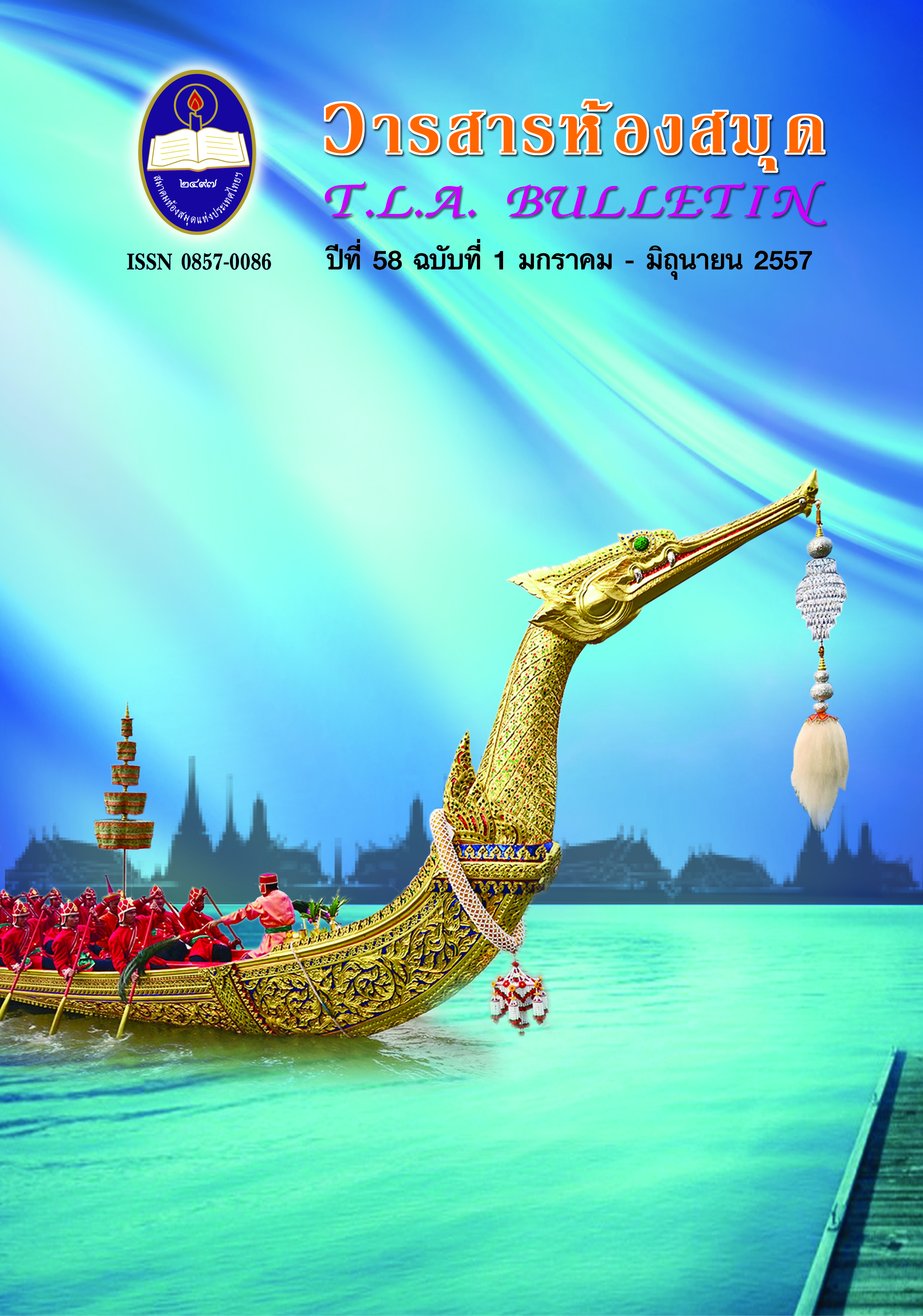Library and information science education and occupations in Thailand : Past, present, and future.
Keywords:
librarianAbstract
The current information society is a knowledge-based society in the present developing countries where the people are engaged in the use of information technology to improve themselves and society as a whole. Library and information science profession is a vital profession to help create a knowledge society. This profession is based on the establishment of the development of the information, the important of the increasing amount of continuous rapidly information demand; causing elements in the study related to library and information science. The establishment of educational institutions for library and information science were undergone at all levels through the world. Trends in the study of library and information science become increasingly important due to the changing rapidly of the knowledge society.
Downloads
References
(A cyclopedia of librarianship).
กรุงเทพฯ: สมาคมห้องสมุดแห่งประเทศไทยฯ.
จุฬาลงกรณ์มหาวิทยาลัย คณะอักษรศาสตร์. (2528). บรรณารักษ์ 30. กรุงเทพฯ.
_______. (2520). ประวัติการทำบัตรรายการและการจัดหมู่หนังสือ. กรุงเทพฯ.
ฉวีลักษณ์ บุญยะกาญจน. (2529). ระบบเปิดของห้องสมุด. วารสารห้องสมุด,
30 (ตุลาคม-ธันวาคม), 54-60.
นงลักษณ์ ไม่หน่ายกิจ. (2524). การศึกษาวิชาสารนิเทศศาสตร์ ณ มหาวิทยาลัยพิทสเบอร์.
ชมรมนิสิตวิชาบรรณารักษ์ศาสตร์จุฬาฯ, 1, 43-52.
_____. (2526). บริการสนเทศ : ความหมายและประเภท. วารสารห้องสมุด,
27 (มกราคม-มีนาคม), 17-23.
_____. (2526). บริการสนเทศระบบออนไลน์. ใน บรรณารักษ์นักเขียน.
กรุงเทพฯ: จุฬาลงกรณ์ มหาวิทยาลัย, หน้า 115-142.
_____. (2529). มหาวิทยาลัยบรรณารักษศาสตร์และสารนิเทศศาสตร์.
ชมรมนิสิตวิชาบรรณารักษศาสตร์จุฬาฯ, 6, 62-72.
_____. (2531). สารนิเทศศาสตร์ : พัฒนาการ ความหมายและขอบเขต.
ใน สารนิเทศศาสตร์ : เอกสารประกอบการสัมมนา.
กรุงเทพฯ:วิทยาลัยครูบ้านสมเด็จเจ้าพระยา. หน้า 295-309.
ราชบัณทิตยสถาน. (2530). พจนานุกรมราชบัณทิตยสถาน พ.ศ. 2525.
พิมพ์ครั้งที่ 3. กรุงเทพฯ : อักษรเจริญทัศน์.
_____. (2531). ศัพท์บัญญัติพร้อมคำอธิบายจากพจนานุกรมฉบับราชบัณฑิตยสถาน พ.ศ. 2525.
กรุงเทพฯ : ธรรมกมลการพิมพ์.
ลานนา ทวีเศรษฐ์. (2530). บัณฑิตศึกษาด้านสารนิเทศ ณ มหาวิทยาลัยชีเรคิวส์ มลรัฐนิวยอร์ค ประเทศ สหรัฐอเมริกา. วารสารห้องสมุด, 31 (3), 75-90.
สุทธิลักษณ์ อำพันวงศ์. (2521). บรรณารักษศาสตร์ภูมิหลัง. กรุงเทพฯ : ไทยวัฒนาพานิช.
ACRL Research Planning and Review Committee. (2014). 2012 top ten trends in academic libraries: A review of the trends and issues affecting academic libraries in higher education.
URL: https://crln.acrl.org/content/73/6/311.full
American Library Association. (1943). A.L.A. glossary of library terms; With a selection of terms
in related fields. Chicago: American Library Association.
Atherton, P. (1981). Library history. In The world book encyclopedia. Vol.12. New York:
Americana Corporation. p. 228-232.
A brief history of librarians and image. (2014).
URL: https://home.earthlink.net/~cyberresearcher/History.htm
Buckland, M. K. (1983). Library services. In Theory and context. New York: Pergamon Press.
Casson, L. (2002). Libraries in the ancient world. New Haven, CT: Yale University Press.
Courses eligible for ALIA membership. (2014).
URL:https://www.alia.org.au/employment-and-careers/courses-eligible-alia-membership
The definition of a library. (2004). URL: https://www.librarylaws.com/
Francis, F. C., Sir. (1980). Library. In The new encyclopaedia Britannica: Macropaedia. Vol. 10.
Chicago: Encyclopaedia Britannica. p. 856-867.
Horko, H. (1968). Information Science: What Is It? American Documentation, 19, 3-5.
International Federation of Library Association. (1976). Standards for library schools. IFLA Journal,
209-223.
Kishida, K. (2011). History and recent trends in library and information science education in Japan. In International Symposium and Information Science Education. Tokyo: Keio Uiniversity.
Krasner-Khait, B. (2014). Survivor: The history of the library.
URL:https://www.history-magazine.com/libraries.html
Lancaster, F. W. (1978). Toward paperless information systems. New York: Acadmic Press.
Miski, A. (1986). Education for information science. In Encylopedia of library and information
science. Vol. 41.New York: Marcel Dekker. p.47-65.
Palmer, R. C. (1987). Online reference and information retrieval. 2nd ed. Littleton, Colorado:
Libraries Unlimited.
Prytherch, R., comp. (1987). Harrodus librariansu glossary. 6th ed. Hants: Gower Publishing.
Reynolds, D. (1985). Library automation: Issues and application. New York: R.R. Bowker.
Richardson, J. V., Jr. (2014). History of American library science: Its origins and early
development. URL: https://polaris.gseis.ucla.edu/jrichardson/ALS.pdf
Saracevic, T. (2009). Information science. In Marcia J. Bates and Mary Niles Maack, eds.
Encyclopedia of Library and Information Science. New York: Taylor & Francis. p. 2570-2586.
Stokes, A. V. (1986). Concise encylopedia of information technology. 3rd ed. Dorset: Wildwood House. Svenonius, E., & Witthus, R. (1981). Information science as a profession. In Annual review of information science and technology. Vol. 16. New York: Knowledge Industry Publication. p. 291-307.
School of Information Studies, Syracuse University. (2014). Ph.D. program.
URL:https://ischool.syr.edu/future/doctoral/phd.aspx
Taylor, R. S. (1966). Professional aspects of information science and technology. In Annual review of information science and technology. Vol.1.New York: Wiley-Interscience. p.15-39.
Toffler, A. (1980). The third wave. New York: William Marror & Co. University of Pittsburgh. (2014). Schools & colleges. URL: https://www.pitt.edu/academics/schools-colleges
Young, H., ed. (1983). The ALA glossary of library and information science. Chicago: American Library Association.



